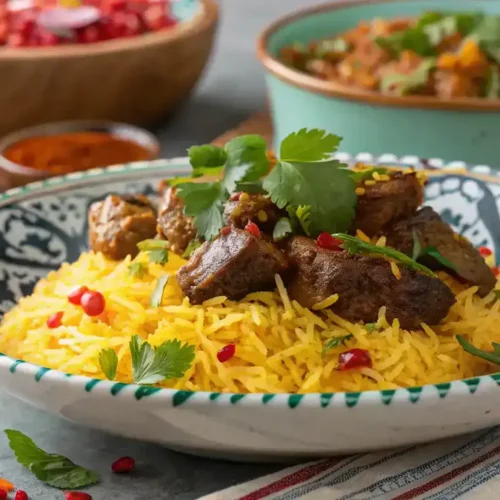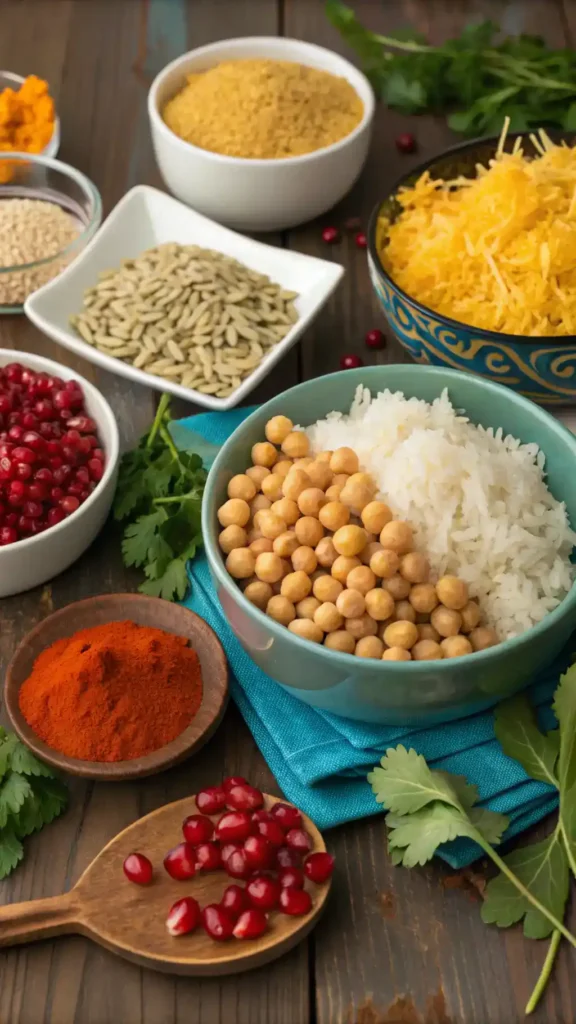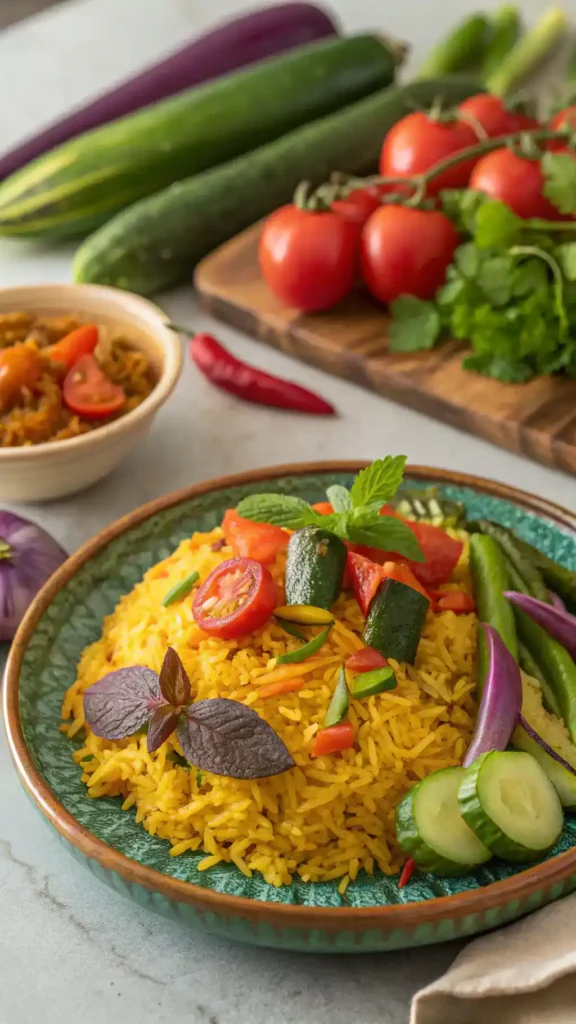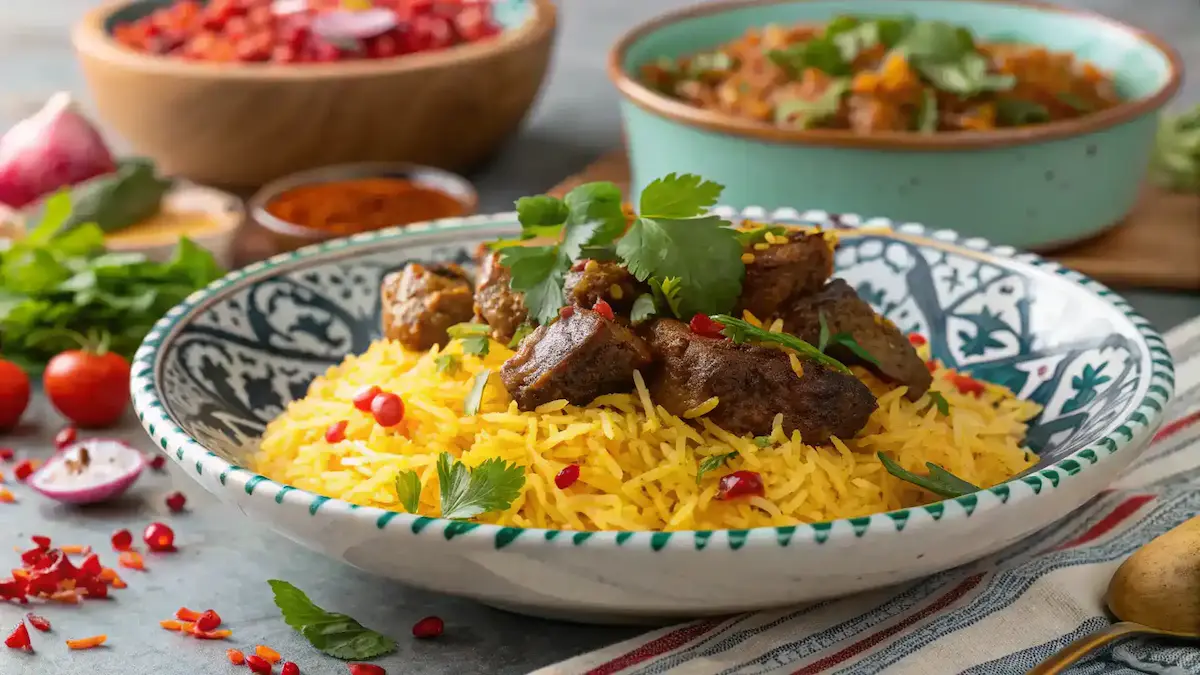Have you ever wondered what makes Iranian cuisine so captivating? The answer lies in its traditional flavors and diverse ingredients. Cooking these dishes not only tantalizes your taste buds but also offers a unique cultural experience. As you explore these iran cuisine recipes, you’ll discover how they can promote health and well-being. Moreover, preparing these meals can foster family bonding, creating cherished memories around the dinner table. So, let’s embark on this culinary journey together and make these recipes truly yours!
Table of Contents
Table of Contents

iran cuisine recipes
Equipment
- 1 Large Pot For cooking stews
- 1 Rice Cooker For cooking basmati rice
- 1 Sauté pan For sautéing onions and spices
Ingredients
Spices
- 1 pinch Saffron Adds aroma and sweetness
- 1 teaspoon Turmeric Earthy flavor and color
Legumes
- 1 cup Chickpeas Provides hearty texture
- 2 cups Basmati Rice Fluffy and fragrant base
Fruits
- 1 cup Pomegranate Adds sweetness and color
Instructions
Gather Your Ingredients
- Start by collecting all the necessary ingredients. For traditional Iranian dishes, you’ll need fresh produce, spices like saffron and turmeric, legumes such as chickpeas, and grains like basmati rice. Having everything ready will streamline your cooking process.
Prepare Your Base
- Begin with the base of your dish. For stews (Khoresh), sauté onions in a bit of oil until they are golden brown. This step is crucial because it builds the foundation of flavor. Additionally, you can add garlic and spices at this stage to enhance the aroma.
Add Proteins or Vegetables
- Once your base is ready, add your choice of protein or vegetables. If you’re making a vegetarian dish, consider using hearty vegetables like eggplant or zucchini. For meat dishes, lamb or chicken works beautifully. Stir well to coat everything in the flavorful base.
Incorporate Liquid
- Next, pour in your liquid. This could be water or vegetable broth, depending on your preference. Ensure that the ingredients are submerged, as this will help them cook evenly. Bring the mixture to a gentle boil.
Simmer to Perfection
- Reduce the heat and let your dish simmer. This step is essential for developing deep flavors. Depending on the recipe, simmering can take anywhere from 30 minutes to a few hours. Stir occasionally to prevent sticking.
Prepare the Rice
- While your stew is simmering, it’s time to prepare the rice. Rinse basmati rice under cold water until the water runs clear. This removes excess starch and ensures fluffy rice. Cook the rice in salted water until it’s tender, then drain and fluff it with a fork.
Layer Flavors
- For dishes like Tahchin, layer your rice with the stew. This technique not only enhances flavor but also creates a beautiful presentation. You can also add a touch of saffron-infused water for extra aroma and color.
Serve with Love
- Finally, serve your Iranian cuisine recipes with a sprinkle of fresh herbs, a dollop of yogurt, or alongside traditional flatbreads. This not only elevates the dish but also adds to the cultural experience of dining.
Key Benefits
Discovering the unique flavours of Iranian cuisine recipes not only tantalises your taste buds but also promotes health and well-being. Cooking these dishes offers a cultural experience that can bring families together, fostering bonding through shared meals. Here are some key benefits of incorporating Iranian cuisine recipes into your cooking routine:
- Nutritional Value: Many Iranian dishes are rich in essential nutrients. For instance, herbs and spices like turmeric and saffron are known for their anti-inflammatory properties, which can support overall health.
- Diverse Ingredients: Iranian cuisine utilizes a variety of fresh produce, legumes, and grains. This diversity ensures a well-rounded diet, providing essential vitamins and minerals.
- Cultural Experience: Cooking Iranian recipes allows you to explore a rich culinary tradition. This experience can deepen your appreciation for different cultures and their histories.
- Family Bonding: Preparing and sharing meals together can strengthen family ties. Engaging in the cooking process encourages teamwork and communication.
- Flavorful and Satisfying: The use of aromatic spices and herbs in Iranian cuisine recipes creates dishes that are not only delicious but also satisfying, making them a great option for any meal.
By embracing these benefits, you can enhance your culinary skills while enjoying the rich flavors of Iranian cuisine recipes.
Ingredients
To create authentic Iranian cuisine recipes, gather fresh produce and essential spices that will elevate your dishes. Here’s a list of key ingredients that embody the rich flavors of Iran:
- Saffron: This precious spice, with its vibrant golden hue, adds a luxurious aroma and a subtle sweetness to your dishes. Just a pinch can transform a simple rice dish into a fragrant masterpiece.
- Turmeric: Known for its earthy flavor and bright yellow color, turmeric not only enhances the visual appeal of your meals but also offers numerous health benefits. It’s a staple in many Iranian stews and rice dishes.
- Chickpeas: These versatile legumes provide a hearty texture and nutty flavor, making them perfect for salads, stews, or as a protein-rich addition to your meals. They are also a great source of plant-based protein.
- Basmati Rice: Renowned for its long grains and delicate aroma, basmati rice is the foundation of many Iranian dishes. When cooked, it becomes fluffy and fragrant, serving as the perfect base for stews and kebabs.
- Pomegranate: This jewel-like fruit adds a burst of sweetness and a pop of color to your dishes. Its tangy seeds can be used in salads, as a garnish, or even in sauces, bringing a refreshing contrast to savory flavors.

Additionally, don’t forget to stock up on fresh herbs like parsley, cilantro, and mint. These herbs not only brighten up your dishes but also add layers of flavor that are quintessential to Iranian cuisine recipes. If you’re looking for substitutes, consider using vegetable broth instead of meat-based options, ensuring that you maintain the essence of the dish while catering to dietary preferences.
How to Make Iran Cuisine Recipes
Making Iranian cuisine recipes is a delightful journey that brings the rich flavors of Iran into your kitchen. Follow these simple steps to create authentic dishes that your family will love.
- Gather Your Ingredients: Start by collecting all the necessary ingredients. For traditional Iranian dishes, you’ll need fresh produce, spices like saffron and turmeric, legumes such as chickpeas, and grains like basmati rice. Having everything ready will streamline your cooking process.
- Prepare Your Base: Begin with the base of your dish. For stews (Khoresh), sauté onions in a bit of oil until they are golden brown. This step is crucial because it builds the foundation of flavor. Additionally, you can add garlic and spices at this stage to enhance the aroma.
- Add Proteins or Vegetables: Once your base is ready, add your choice of protein or vegetables. If you’re making a vegetarian dish, consider using hearty vegetables like eggplant or zucchini. For meat dishes, lamb or chicken works beautifully. Stir well to coat everything in the flavorful base.
- Incorporate Liquid: Next, pour in your liquid. This could be water or vegetable broth, depending on your preference. Ensure that the ingredients are submerged, as this will help them cook evenly. Bring the mixture to a gentle boil.
- Simmer to Perfection: Reduce the heat and let your dish simmer. This step is essential for developing deep flavors. Depending on the recipe, simmering can take anywhere from 30 minutes to a few hours. Stir occasionally to prevent sticking.
- Prepare the Rice: While your stew is simmering, it’s time to prepare the rice. Rinse basmati rice under cold water until the water runs clear. This removes excess starch and ensures fluffy rice. Cook the rice in salted water until it’s tender, then drain and fluff it with a fork.
- Layer Flavors: For dishes like Tahchin, layer your rice with the stew. This technique not only enhances flavor but also creates a beautiful presentation. You can also add a touch of saffron-infused water for extra aroma and color.
- Serve with Love: Finally, serve your Iranian cuisine recipes with a sprinkle of fresh herbs, a dollop of yogurt, or alongside traditional flatbreads. This not only elevates the dish but also adds to the cultural experience of dining.

By following these steps, you’ll create delicious Iranian cuisine recipes that reflect the rich culinary traditions of Iran. Enjoy the process and share these meals with your loved ones for a truly memorable experience!
Pro Tips, Variations, and Common Problems
When diving into Iranian cuisine recipes, consider these expert tips to elevate your cooking experience. Firstly, adjust cooking times based on the protein or vegetable used to ensure optimal texture. For instance, if you’re using chicken, it may require less time than beef. Additionally, if you encounter issues with flavor, experiment with ingredient substitutions. For example, use lemon juice for acidity instead of vinegar, which can alter the dish’s profile. Moreover, variations can include adding seasonal vegetables to recipes, allowing for a fresh twist on traditional dishes while maintaining their core identity.
Furthermore, if your dish turns out too salty, add a bit of sugar or a splash of water to balance the flavors. If you find your rice is sticky, rinse it under cold water before cooking to remove excess starch. Conversely, if your rice is too dry, add a little broth or water during the cooking process to achieve the desired consistency. Lastly, remember that flavor develops over time, so allowing your stews to simmer longer can enhance their richness.
In terms of substitutions, if you can’t find saffron, turmeric can provide a similar color, albeit with a different flavor. For a vegetarian option, chickpeas can replace meat in many dishes, offering both protein and texture. Also, consider using basmati rice alternatives like jasmine rice if you prefer a different aroma. Overall, these tips and variations will help you navigate common problems while making Iranian cuisine recipes, ensuring a delightful cooking experience.
Serving Suggestions
Serving Iranian cuisine recipes can be a delightful experience that enhances both flavor and presentation. Here are some engaging ways to plate and serve your dishes:
- Colorful Plating: Begin by using a large, vibrant platter to showcase your main dish. For instance, if you’re serving a fragrant Khoresh, arrange it in the center, allowing the rich colors to draw attention.
- Fresh Herbs: Garnish your dishes with a sprinkle of fresh herbs, such as parsley or mint. This not only adds a pop of color but also enhances the aroma, making your meal even more inviting.
- Yogurt Delight: Serve a side of creamy yogurt topped with a drizzle of olive oil and a sprinkle of sumac. This traditional accompaniment complements the spices in Iranian cuisine recipes beautifully.
- Flatbreads: Offer warm, fluffy flatbreads like lavash or naan on the side. They are perfect for scooping up stews and add a comforting touch to the meal.
- Family-Style Serving: Embrace the cultural custom of serving meals family-style. Place all dishes on the table, allowing everyone to help themselves. This creates a warm, communal atmosphere that encourages sharing and bonding.
- Seasonal Sides: Pair your main dish with seasonal side dishes, such as a refreshing Shirazi salad or saffron-infused rice. These additions not only enhance the meal but also provide a balance of flavors and textures.
By incorporating these serving suggestions, you can elevate your Iranian cuisine recipes, making them not only delicious but also visually stunning. Remember, the presentation is key to impressing your guests and creating a memorable dining experience!
Preserving and Reheating Iranian Cuisine Recipes
To maintain the delightful flavors and textures of your Iranian cuisine recipes, proper storage and reheating techniques are essential. Firstly, when it comes to storage, always use airtight containers to keep your dishes fresh. For refrigeration, most cooked Iranian dishes can last up to 3-4 days. If you want to store them for a longer period, consider freezing. In the freezer, these recipes can stay fresh for up to 3 months. However, it’s important to label your containers with the date to keep track of freshness.
Additionally, ensure that your food is cooled to room temperature before sealing it in containers. This practice helps prevent condensation, which can lead to spoilage or bacterial growth. For food safety, always reheat leftovers to an internal temperature of 165°F (74°C) to eliminate any potential bacteria.
Reheating Methods
When it comes to reheating your Iranian cuisine recipes, there are several effective methods to choose from. For stews and rice dishes, the stovetop is often the best option. Start by adding a splash of water or broth to the pan to prevent drying out. Heat over medium-low heat, stirring occasionally, until warmed through. This method helps retain the dish’s original texture and flavor.
If you prefer using the microwave, place your food in a microwave-safe dish and cover it with a damp paper towel. This technique adds moisture and prevents the dish from becoming rubbery. Heat in short intervals, stirring in between, until hot. Alternatively, the oven can be used for reheating kebabs or baked dishes. Preheat your oven to 350°F (175°C), place the dish in an oven-safe container, and cover it with foil to keep moisture in. Heat for about 15-20 minutes or until warmed through.
For an extra crispy texture, consider using an air fryer. Simply preheat the air fryer to 350°F (175°C) and place your food inside for about 5-10 minutes, checking frequently to avoid overcooking. Regardless of the method you choose, always remember to add a little moisture if needed, especially for rice dishes, to refresh them beautifully. By following these storage and reheating tips, you can enjoy your Iranian cuisine recipes just as much as the first time you made them!
Conclusion
As you embark on your culinary journey with Iranian cuisine recipes, remember that simplicity and versatility are at the heart of these delightful dishes. Not only are they easy to prepare, but they also offer a wonderful opportunity to explore traditional flavors that can bring your family together around the dinner table. So, why not give this recipe a try? You might just discover a new favorite that you’ll want to make again and again.
Moreover, I encourage you to share your results or ask any questions you may have. Your cooking experience is unique, and I would love to hear how you made this recipe your own! Feel free to experiment with variations or pairings that suit your taste. After all, cooking is meant to be fun and creative, especially when it comes to Iranian cuisine recipes.
In conclusion, dive into the vibrant world of flavors that Iranian cuisine offers. With each dish you create, you’re not just cooking; you’re embracing a rich cultural heritage that celebrates family and togetherness. So, gather your ingredients, roll up your sleeves, and enjoy the process. Happy cooking!
FAQs about Iran Cuisine Recipes
Here are some common questions you might have about Iranian cuisine recipes, along with helpful answers to enhance your cooking experience.
1. What are some essential spices used in Iranian cuisine?
Essential spices include saffron, turmeric, cumin, and sumac. These spices not only add flavor but also bring vibrant colors to your dishes. For instance, saffron is often used in rice dishes, while sumac adds a tangy touch to salads.
2. Can I make Iranian dishes vegetarian?
Absolutely! Many Iranian recipes can be easily adapted to vegetarian versions. For example, you can replace meat in stews with hearty vegetables or legumes like chickpeas. This way, you maintain the essence of the dish while catering to vegetarian diets.
3. How can I adjust the spice levels in my dishes?
If you prefer milder flavors, start by using less of the spices and gradually increase them to your taste. Additionally, you can balance heat by adding yogurt or a squeeze of lemon juice, which can help tone down spiciness.
4. What is the best way to serve Iranian dishes?
Serving Iranian dishes family-style is a wonderful way to enjoy the meal. Present your dishes on a large platter, accompanied by fresh herbs, yogurt, and flatbreads. This not only enhances the dining experience but also encourages sharing and conversation.
5. How do I store and reheat leftovers?
Store leftovers in airtight containers to keep them fresh. For reheating, use the stovetop when possible, as it helps retain the dish’s original texture and flavor. This method is particularly effective for rice dishes and stews, ensuring they taste just as delicious the next day.
Your Flavorful Feedback
There are no reviews yet. Be the first one to write one.

